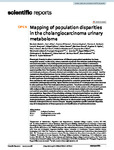Mapping of population disparities in the cholangiocarcinoma urinary metabolome
| dc.contributor.author | Alsaleh, M | |
| dc.contributor.author | Leftley, Z | |
| dc.contributor.author | O’Connor, T | |
| dc.contributor.author | Hughes, T | |
| dc.contributor.author | Barbera, TA | |
| dc.contributor.author | Koomson, LK | |
| dc.contributor.author | Zabron, A | |
| dc.contributor.author | Reeves, H | |
| dc.contributor.author | Cramp, Matthew | |
| dc.contributor.author | Ryder, SD | |
| dc.contributor.author | Greer, S | |
| dc.contributor.author | Prince, M | |
| dc.contributor.author | Sithithaworn, P | |
| dc.contributor.author | Khuntikeo, N | |
| dc.contributor.author | Loilome, W | |
| dc.contributor.author | Yongvanit, P | |
| dc.contributor.author | Cox, IJ | |
| dc.contributor.author | Williams, R | |
| dc.contributor.author | Wadsworth, CA | |
| dc.contributor.author | Holmes, E | |
| dc.contributor.author | Nash, K | |
| dc.contributor.author | Andrews, R | |
| dc.contributor.author | Taylor-Robinson, SD | |
| dc.date.accessioned | 2021-11-30T12:06:14Z | |
| dc.date.issued | 2021-10-28 | |
| dc.identifier.issn | 2045-2322 | |
| dc.identifier.issn | 2045-2322 | |
| dc.identifier.other | 21286 | |
| dc.identifier.uri | http://hdl.handle.net/10026.1/18425 | |
| dc.description.abstract |
<jats:title>Abstract</jats:title><jats:p>Phenotypic diversity in urinary metabolomes of different geographical populations has been recognized recently. In this study, urinary metabolic signatures from Western (United Kingdom) and South-East Asian (Thai) cholangiocarcinoma patients were characterized to understand spectral variability due to host carcinogenic processes and/or exogenous differences (nutritional, environmental and pharmaceutical). Urinary liquid chromatography mass spectroscopy (LC–MS) spectral profiles from Thai (healthy = 20 and cholangiocarcinoma = 14) and UK cohorts (healthy = 22 and cholangiocarcinoma = 10) were obtained and modelled using chemometric data analysis. Healthy metabolome disparities between the two distinct populations were primarily related to differences in dietary practices and body composition. Metabolites excreted due to drug treatment were dominant in urine specimens from cholangiocarcinoma patients, particularly in Western individuals. Urine from participants with sporadic (UK) cholangiocarcinoma contained greater levels of a nucleotide metabolite (uridine/pseudouridine). Higher relative concentrations of 7-methylguanine were observed in urine specimens from Thai cholangiocarcinoma patients. The urinary excretion of hippurate and methyladenine (gut microbial-host co-metabolites) showed a similar pattern of lower levels in patients with malignant biliary tumours from both countries. Intrinsic (body weight and body composition) and extrinsic (xenobiotic metabolism) factors were the main causes of disparities between the two populations. Regardless of the underlying aetiology, biological perturbations associated with cholangiocarcinoma urine metabolome signatures appeared to be influenced by gut microbial community metabolism. Dysregulation in nucleotide metabolism was associated with sporadic cholangiocarcinoma, possibly indicating differences in mitochondrial energy production pathways between cholangiocarcinoma tumour subtypes. Mapping population-specific metabolic disparities may aid in interpretation of disease processes and identification of candidate biomarkers.</jats:p> | |
| dc.format.extent | 21286- | |
| dc.format.medium | Electronic | |
| dc.language | en | |
| dc.language.iso | en | |
| dc.publisher | Nature Research | |
| dc.subject | Adult | |
| dc.subject | Aged | |
| dc.subject | Aged, 80 and over | |
| dc.subject | Biological Variation, Population | |
| dc.subject | Biomarkers | |
| dc.subject | Cholangiocarcinoma | |
| dc.subject | Chromatography, Liquid | |
| dc.subject | Female | |
| dc.subject | Humans | |
| dc.subject | Male | |
| dc.subject | Mass Spectrometry | |
| dc.subject | Metabolome | |
| dc.subject | Metabolomics | |
| dc.subject | Middle Aged | |
| dc.subject | Population Surveillance | |
| dc.subject | Thailand | |
| dc.subject | United Kingdom | |
| dc.title | Mapping of population disparities in the cholangiocarcinoma urinary metabolome | |
| dc.type | journal-article | |
| dc.type | Journal Article | |
| dc.type | Research Support, Non-U.S. Gov't | |
| plymouth.author-url | https://www.webofscience.com/api/gateway?GWVersion=2&SrcApp=PARTNER_APP&SrcAuth=LinksAMR&KeyUT=WOS:000712564800051&DestLinkType=FullRecord&DestApp=ALL_WOS&UsrCustomerID=11bb513d99f797142bcfeffcc58ea008 | |
| plymouth.issue | 1 | |
| plymouth.volume | 11 | |
| plymouth.publication-status | Published online | |
| plymouth.journal | Scientific Reports | |
| dc.identifier.doi | 10.1038/s41598-021-00530-0 | |
| plymouth.organisational-group | /Plymouth | |
| plymouth.organisational-group | /Plymouth/Faculty of Health | |
| plymouth.organisational-group | /Plymouth/Faculty of Health/Peninsula Medical School | |
| plymouth.organisational-group | /Plymouth/REF 2021 Researchers by UoA | |
| plymouth.organisational-group | /Plymouth/REF 2021 Researchers by UoA/UoA01 Clinical Medicine | |
| plymouth.organisational-group | /Plymouth/Research Groups | |
| plymouth.organisational-group | /Plymouth/Research Groups/Institute of Translational and Stratified Medicine (ITSMED) | |
| plymouth.organisational-group | /Plymouth/Research Groups/Institute of Translational and Stratified Medicine (ITSMED)/CBR | |
| plymouth.organisational-group | /Plymouth/Users by role | |
| plymouth.organisational-group | /Plymouth/Users by role/Academics | |
| dc.publisher.place | England | |
| dcterms.dateAccepted | 2021-10-11 | |
| dc.rights.embargodate | 2021-12-1 | |
| dc.identifier.eissn | 2045-2322 | |
| dc.rights.embargoperiod | Not known | |
| rioxxterms.versionofrecord | 10.1038/s41598-021-00530-0 | |
| rioxxterms.licenseref.uri | http://www.rioxx.net/licenses/all-rights-reserved | |
| rioxxterms.licenseref.startdate | 2021-10-28 | |
| rioxxterms.type | Journal Article/Review |


